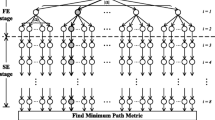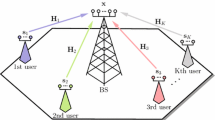Abstract
This paper presents a low complexity pairwise layered tabu search based detection algorithm for a large-scale multiple-input multiple-output system. The proposed algorithm can compute two layers simultaneously and reduce the effective number of tabu searches. An efficient Gram matrix and matched filtered output update strategy is developed to reuse the computations from past visited layers. Also, a precomputation technique is adapted to reduce the redundancy in computation within tabu search iterations. Complexity analysis shows that the upper bound of initialization complexity in the proposed algorithm reduces from \(O(N_t^4)\) to \(O(N_t^3)\). The detection performance of the proposed detector is almost the same as the conventional complex version of LTS for 64QAM and 16QAM modulations. However, the proposed detector outperforms the conventional system for 4QAM modulation, especially in \(16 \times 16\) and \(8 \times 8\) MIMO. Simulation results show that the percent of complexity reduction in the proposed method is approximately 75% for \(64 \times 64\), 64QAM and 85% for \(64 \times 64\) 16QAM systems to achieve a BER of \(10^{-3}\). Moreover, we have proposed three layer-wise iteration allocation strategies that can further reduce the upper bound of complexity with minor degradation in detection performance.








Similar content being viewed by others
Availability of data and materials
Not applicable.
Code availability
Yes.
References
Albreem, M. A., Juntti, M., & Shahabuddin, S. (2019). Massive MIMO detection techniques: A survey. IEEE Communications Surveys and Tutorials, 21(4), 3109–3132. https://doi.org/10.1109/COMST.2019.2935810.
Azzam, L., & Ayanoglu, E. (2007). Reduced complexity sphere decoding for square QAM via a new lattice representation. In GLOBECOM—IEEE global telecommunications conference (pp. 4242–4246).
Barbero, L. G., & Thompson, J. S. (2008). Fixing the complexity of the sphere decoder for MIMO detection. IEEE Transactions on Wireless Communications, 7(6), 2131–2142.
Burg, A., Borgmann, M., Wenk, M., Zellweger, M., Fichtner, W., & Bölcskei, H. (2005). VLSI Implementation of MIMO detection using the sphere decoding algorithm. IEEE Journal of Solid-State Circuits, 40(7), 1566–1576.
Chakraborty, S., Sinha, N. B., & Mitra, M. (2021). Iteration optimized layered tabu search for large scale MIMO detection. In 2021 10th international conference on internet of everything, microwave engineering, communication and networks (IEMECON) (pp. 1–5). https://doi.org/10.1109/IEMECON53809.2021.9689202.
Datta, T., Srinidhi, N., Chockalingam, A., & Rajan, B. S. (2010). Random-restart reactive tabu search algorithm for detection in large-MIMO systems. IEEE Communications Letters, 14(12), 1107–1109.
Datta, T., Srinidhi, N., Chockalingam, A., & Rajan, B. S. (2012). Low-complexity near-optimal signal detection in underdetermined large-mimo systems. In 2012 national conference on communications (NCC) (pp. 1–5). https://doi.org/10.1109/NCC.2012.6176823.
Glover, F. (1989). Tabu search-Part I. ORSA Journal on Computing, 1(3), 190–206.
Glover, F. (1990). Tabu search-Part II. ORSA Journal on Computing, 2(1), 4–32.
Jung, I., Kim, H., Jeong, J., Choi, S., & Hong, D. (2019). An enhanced tabu search based receiver for full-spreading NOMA systems. IEEE Access, 7, 159899–159917. https://doi.org/10.1109/ACCESS.2019.2950901.
Karthikeyan, M., & Saraswady, D. (2018). Low complexity layered tabu search detection in large MIMO systems. AEU—International Journal of Electronics and Communications, 83, 106–113.
Kim, T. H. (2014). Low-complexity sorted QR decomposition for MIMO systems based on pairwise column symmetrization. IEEE Transactions on Wireless Communications, 13(3), 1388–1396.
Liu, L., Ma, X., Ye, F., & Ren, J. (2008). Design of highly-parallel, 2.2 Gbps throughput signal detector for MIMO systems. In IEEE international conference on communications (pp. 742–745).
Lofgren, J., & Nilsson, P. (2008). On MIMO K-best sphere detector architecture complexity reductions. In Proceedings of the 2nd international conference on signal processing and communication systems, ICSPCS 2008 (pp. 1–9).
Marzetta, T. L. (2010). Noncooperative cellular wireless with unlimited numbers of base station antennas. IEEE Transactions on Wireless Communications, 9(11), 3590–3600.
Ngo, H. Q., Larsson, E. G., & Marzetta, T. L. (2013). Energy and spectral efficiency of very large multiuser MIMO systems. IEEE Transactions on Communications, 61(4), 1436–1449.
Nguyen, N. T., & Lee, K. (2020). Deep learning-aided tabu search detection for large MIMO systems. IEEE Transactions on Wireless Communications, 19(6), 4262–4275. https://doi.org/10.1109/TWC.2020.2981919.
Nguyen, N. T., & Lee, K. (2020). Groupwise neighbor examination for tabu search detection in large MIMO systems. IEEE Transactions on Vehicular Technology, 69(1), 1136–1140.
Nguyen, N. T., Lee, K., & Dai, H. (2019). QR-Decomposition-aided tabu search detection for large MIMO Systems. IEEE Transactions on Vehicular Technology, 68(5), 4857–4870.
Sah, A. K., & Chaturvedi, A. K. (2018). Sequential and global likelihood ascent search-based detection in large MIMO systems. IEEE Transactions on Communications, 66(2), 713–725.
Srinidhi, N., Datta, T., Chockalingam, A., & Rajan, B. S. (2011). Layered tabu search algorithm for large-MIMO detection and a lower bound on ML performance. IEEE Transactions on Communications, 59(11), 2955–2963.
Srinidhi, N., Mohammed, S. K., Chockalingam, A., & Rajan, B. S. (2009). Low- complexity near-ML decoding of large non-orthogonal STBCs using reactive tabu search. In Proceedings of the IEEE international symposium on information theory (pp. 1993–1997).
Srinidhi, N., Mohammed, S. K., Chockalingam, A., & Rajan, B. S. (2009). Near-ML signal detection in large-dimension linear vector channels using reactive tabu search. arXiv:0911.4640.
Vardhan, K. V., Mohammed, S. K., Chockalingam, A., & Rajan, B. S. (2008). A low-complexity detector for large MIMO systems and multicarrier CDMA systems. IEEE Journal on Selected Areas in Communications, 26(3), 473–485.
Wu, Y., & McAllister, J. (2014). FPGA-based tabu search for detection in large-scale MIMO systems. In 2014 IEEE workshop on signal processing systems (SiPS) (pp. 1–6). https://doi.org/10.1109/SiPS.2014.6986073.
Yang, S., & Hanzo, L. (2015). Fifty years of MIMO detection: The road to large-scale MIMOs. IEEE Communications Surveys and Tutorials, 17(4), 1941–1988. https://doi.org/10.1109/COMST.2015.2475242.
Zhao, H., Long, H., & Wang, W. (2007). Tabu search detection for MIMO systems. In IEEE international symposium on personal, indoor and mobile radio communications, PIMRC (pp. 1–5).
Funding
None.
Author information
Authors and Affiliations
Contributions
All the authors have contributed to complete this work and preparing this manuscript.
Corresponding author
Ethics declarations
Conflict of interest
All authors declares that they have no conflict of interest
Additional information
Publisher's Note
Springer Nature remains neutral with regard to jurisdictional claims in published maps and institutional affiliations.
Appendix: Proof of property 2 and 3 of W
Appendix: Proof of property 2 and 3 of W
Proof of property 2: \(W_{2i,2i-1} = W_{2i-1,2i} = 0\)
Using (30), \((2i,2i-1)\)th element of \(\varvec{W}\) can be expressed as
From (5) and (6), we can write, \(R_{2n,2i} = R_{2n-1,2i-1}\) and \(R_{2n,2i-1} = - R_{2n-1,2i}\). Substituting \(R_{2n,2i}\) and \(R_{2n,2i-1}\) in (51) we can obtain \(W_{2i,2i-1} = 0\). Also, \(W_{2i-1,2i}= 0\) as \(W_{i,j} = W_{j,i}\) from property 1 of \(\varvec{W}\).
Proof of property 3: \(W_{2i-1,2j-1} = W_{2i,2j}\) and \(W_{2i-1,2j} = -W_{2i,2j-1}\)
From (30), \(W_{2i-1,2j-1}\) can be computed as
Using (5) and (6), we can substitute \(R_{2n,2i-1}\), \(R_{2n,2j-1}\), \(R_{2n-1,2i-1}\) and \(R_{2n-1,2j-1}\) in (52) by \(-R_{2n-1,2i}\), \(-R_{2n-1,2j}\), \(R_{2n,2i}\) and \(R_{2n,2j}\) respectively. Therefore, (52) can be expressed as
In a similar way we can prove \(W_{2i-1,2j} = -W_{2i,2j-1}\). The element \(W_{2i-1,2j}\) can be expressed as
Using (5) and (6), we can substitute \(R_{2n,2i-1}\), \(R_{2n,2j-1}\), \(R_{2n-1,2i-1}\) and \(R_{2n-1,2j-1}\) in (54) by \(-R_{2n-1,2i}\), \(-R_{2n-1,2j}\),\(R_{2n,2i}\) and \(R_{2n,2j}\) respectively. Therefore, (54) can be expressed as
Rights and permissions
Springer Nature or its licensor holds exclusive rights to this article under a publishing agreement with the author(s) or other rightsholder(s); author self-archiving of the accepted manuscript version of this article is solely governed by the terms of such publishing agreement and applicable law.
About this article
Cite this article
Chakraborty, S., Sinha, N.B. & Mitra, M. Low Complexity, Pairwise Layered Tabu Search for Large Scale MIMO Detection. Wireless Pers Commun 128, 1689–1713 (2023). https://doi.org/10.1007/s11277-022-10015-6
Accepted:
Published:
Issue Date:
DOI: https://doi.org/10.1007/s11277-022-10015-6




